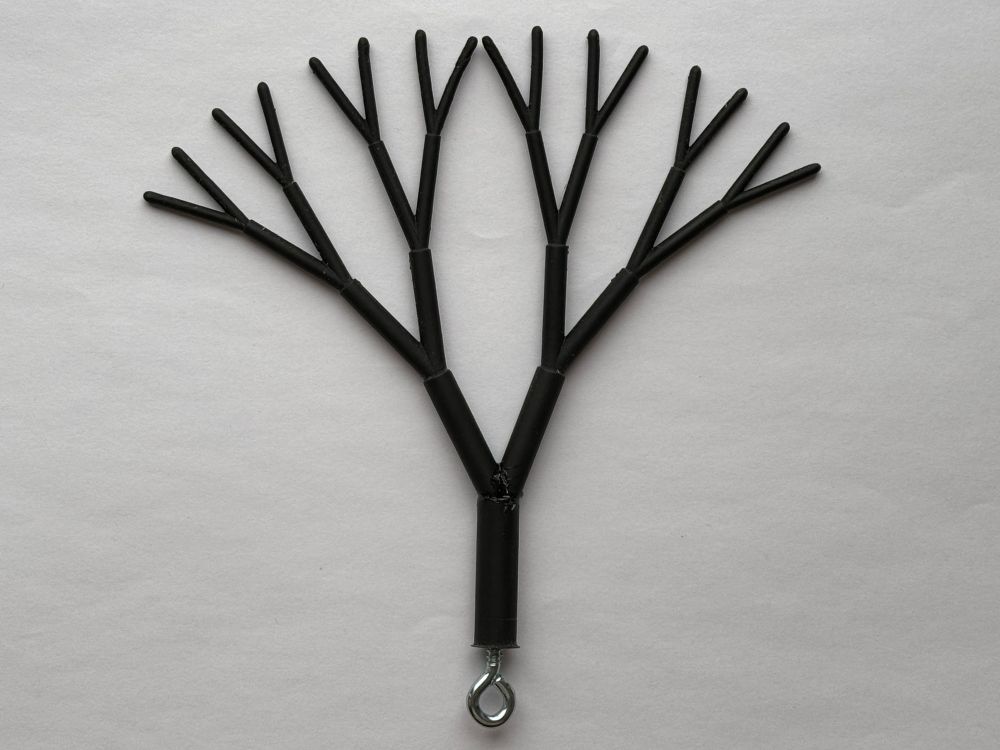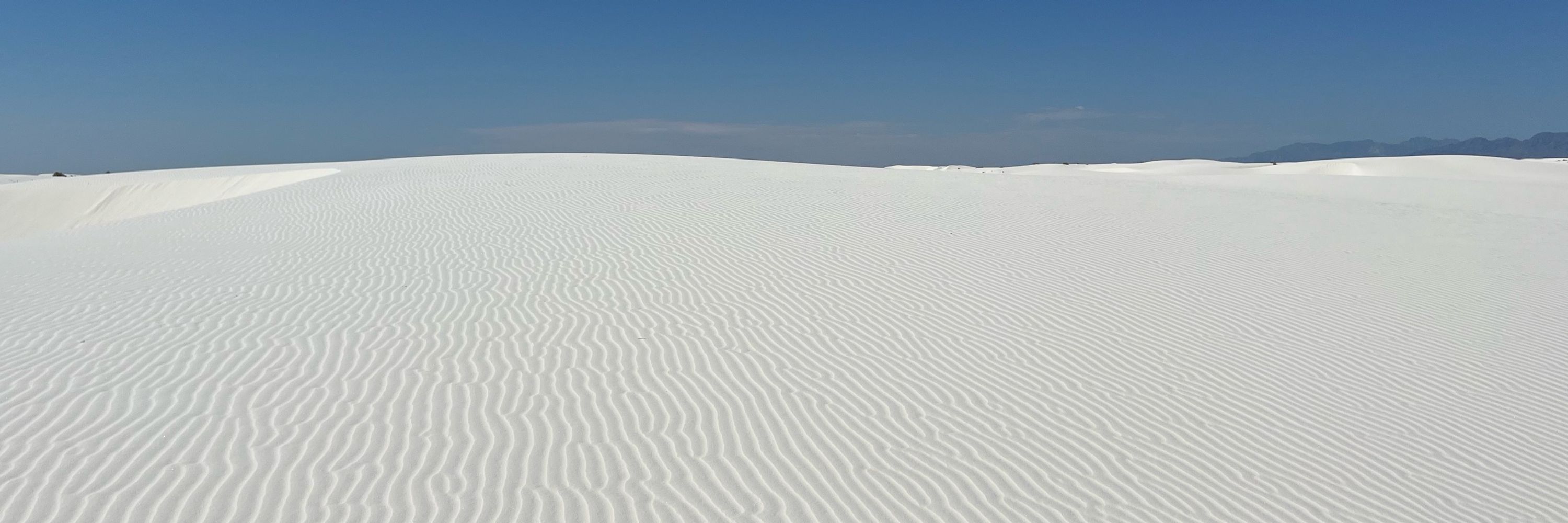
M. Colin Marvin
@mcolinmarvin.bsky.social
Earth and Planetary Sciences PhD candidate @Stanford studying planetary surface processes, specifically bedform patterns and sediments
Reposted by M. Colin Marvin
What would you share with an earlier version of yourself?

What I wish I knew: 33 thoughts for early career researchers
Thirty three reflections I wish someone had shared with me early in my research career.
predirections.substack.com
November 11, 2025 at 12:41 AM
What would you share with an earlier version of yourself?
Reposted by M. Colin Marvin
Did you know sand grains record their transport history?
New research in Geology shows zircon grains reveal their journey through microscopic abrasion “microtextures”—even in billion-year-old rocks!
Read more: geosociety.co/4oHG2J6
#Geology #GSAPubs
New research in Geology shows zircon grains reveal their journey through microscopic abrasion “microtextures”—even in billion-year-old rocks!
Read more: geosociety.co/4oHG2J6
#Geology #GSAPubs

November 1, 2025 at 12:32 PM
Did you know sand grains record their transport history?
New research in Geology shows zircon grains reveal their journey through microscopic abrasion “microtextures”—even in billion-year-old rocks!
Read more: geosociety.co/4oHG2J6
#Geology #GSAPubs
New research in Geology shows zircon grains reveal their journey through microscopic abrasion “microtextures”—even in billion-year-old rocks!
Read more: geosociety.co/4oHG2J6
#Geology #GSAPubs
take a sec to check out our paper on zircon micro-abrasion features and what they can tell us about Earth’s surface billions of years ago (hot of the proverbial press in @geosociety.bsky.social)!
Did you know sand grains record their transport history?
New research in Geology shows zircon grains reveal their journey through microscopic abrasion “microtextures”—even in billion-year-old rocks!
Read more: geosociety.co/4oHG2J6
#Geology #GSAPubs
New research in Geology shows zircon grains reveal their journey through microscopic abrasion “microtextures”—even in billion-year-old rocks!
Read more: geosociety.co/4oHG2J6
#Geology #GSAPubs

November 1, 2025 at 4:21 PM
take a sec to check out our paper on zircon micro-abrasion features and what they can tell us about Earth’s surface billions of years ago (hot of the proverbial press in @geosociety.bsky.social)!
Reposted by M. Colin Marvin
Yooo how about those Mariners??!!!
October 18, 2025 at 1:02 AM
Yooo how about those Mariners??!!!
Reposted by M. Colin Marvin
Just out: PhD candidate @mcolinmarvin.bsky.social shows that like in quartz, #zircon grains preserve microscopic archives of their transport history. But unlike in quartz, those archives remain decipherable for billions of years, unlocking first 90% of #Earth ’s history
@stanforddoerr.bsky.social
@stanforddoerr.bsky.social


October 16, 2025 at 4:39 PM
Just out: PhD candidate @mcolinmarvin.bsky.social shows that like in quartz, #zircon grains preserve microscopic archives of their transport history. But unlike in quartz, those archives remain decipherable for billions of years, unlocking first 90% of #Earth ’s history
@stanforddoerr.bsky.social
@stanforddoerr.bsky.social
Did you know that sand records its transport history as it moves across Earth's surface? We developed a new tool to investigate billion-year-old rocks by looking at microscopic features on zircon sand grains. Check out our new paper in @geosociety.bsky.social to see how!
doi.org/10.1130/G537...
doi.org/10.1130/G537...


October 16, 2025 at 6:44 AM
Did you know that sand records its transport history as it moves across Earth's surface? We developed a new tool to investigate billion-year-old rocks by looking at microscopic features on zircon sand grains. Check out our new paper in @geosociety.bsky.social to see how!
doi.org/10.1130/G537...
doi.org/10.1130/G537...
Reposted by M. Colin Marvin
eBook Preview
Statistical Physics of Rarefied Sediment Particle Motions and Transport: Applications to Hillslopes and Rivers
Posting this preview of material from my next (unfinished) book might be a mistake. But eh… what the hell.
1/n
cdn.vanderbilt.edu/t2-my/my-prd...
Statistical Physics of Rarefied Sediment Particle Motions and Transport: Applications to Hillslopes and Rivers
Posting this preview of material from my next (unfinished) book might be a mistake. But eh… what the hell.
1/n
cdn.vanderbilt.edu/t2-my/my-prd...
cdn.vanderbilt.edu
September 1, 2025 at 9:15 PM
eBook Preview
Statistical Physics of Rarefied Sediment Particle Motions and Transport: Applications to Hillslopes and Rivers
Posting this preview of material from my next (unfinished) book might be a mistake. But eh… what the hell.
1/n
cdn.vanderbilt.edu/t2-my/my-prd...
Statistical Physics of Rarefied Sediment Particle Motions and Transport: Applications to Hillslopes and Rivers
Posting this preview of material from my next (unfinished) book might be a mistake. But eh… what the hell.
1/n
cdn.vanderbilt.edu/t2-my/my-prd...
Reposted by M. Colin Marvin
Findings from a recent study could upend the conventional view of how rivers have shaped continents over time.
It’s “a significant revision to our understanding of the history of the Earth,” said lead author Michael Hasson.
@marslogander.bsky.social
It’s “a significant revision to our understanding of the history of the Earth,” said lead author Michael Hasson.
@marslogander.bsky.social

The rise of plant life changed how rivers move, study shows
Research reveals that unvegetated meandering rivers can geologically masquerade as braided rivers, suggesting they were much more common in the first 90 percent of Earth’s history than previously thou...
stanford.io
August 25, 2025 at 4:08 PM
Findings from a recent study could upend the conventional view of how rivers have shaped continents over time.
It’s “a significant revision to our understanding of the history of the Earth,” said lead author Michael Hasson.
@marslogander.bsky.social
It’s “a significant revision to our understanding of the history of the Earth,” said lead author Michael Hasson.
@marslogander.bsky.social
Reposted by M. Colin Marvin
So proud of Michael!! 😎
This work was a collaboration with @alvitello.bsky.social at @unipd.bsky.social and A. Ielpi and @ubcokanagan.bsky.social
Check also:
- Perspective by J. Pizzuto: doi.org/10.1126/scie...
- Stanford’s press release: sustainability.stanford.edu/news/rise-pl...
This work was a collaboration with @alvitello.bsky.social at @unipd.bsky.social and A. Ielpi and @ubcokanagan.bsky.social
Check also:
- Perspective by J. Pizzuto: doi.org/10.1126/scie...
- Stanford’s press release: sustainability.stanford.edu/news/rise-pl...
August 22, 2025 at 7:17 PM
So proud of Michael!! 😎
This work was a collaboration with @alvitello.bsky.social at @unipd.bsky.social and A. Ielpi and @ubcokanagan.bsky.social
Check also:
- Perspective by J. Pizzuto: doi.org/10.1126/scie...
- Stanford’s press release: sustainability.stanford.edu/news/rise-pl...
This work was a collaboration with @alvitello.bsky.social at @unipd.bsky.social and A. Ielpi and @ubcokanagan.bsky.social
Check also:
- Perspective by J. Pizzuto: doi.org/10.1126/scie...
- Stanford’s press release: sustainability.stanford.edu/news/rise-pl...
Reposted by M. Colin Marvin
Plants change how river bends move - paper by PhD student Michael Hasson out as First Release in #Science!!
Paper: doi.org/10.1126/scie...
Before #plants, #meanders did not grow laterally as much but translated downstream, making them look like braided rivers in rocks.
@stanforddoerr.bsky.social
Paper: doi.org/10.1126/scie...
Before #plants, #meanders did not grow laterally as much but translated downstream, making them look like braided rivers in rocks.
@stanforddoerr.bsky.social

Vegetation changes the trajectory of river bends
A primary axiom in geoscience is that the evolution of plants drove global changes in river dynamics. Notably, the apparent sinuosity of rivers, derived from the variance of sediment accretion directi...
doi.org
August 22, 2025 at 7:17 PM
Plants change how river bends move - paper by PhD student Michael Hasson out as First Release in #Science!!
Paper: doi.org/10.1126/scie...
Before #plants, #meanders did not grow laterally as much but translated downstream, making them look like braided rivers in rocks.
@stanforddoerr.bsky.social
Paper: doi.org/10.1126/scie...
Before #plants, #meanders did not grow laterally as much but translated downstream, making them look like braided rivers in rocks.
@stanforddoerr.bsky.social
Reposted by M. Colin Marvin
Sand grains from Coral Pink Sand Dunes State Park, Utah 🧪⚒️




May 16, 2025 at 12:31 AM
Sand grains from Coral Pink Sand Dunes State Park, Utah 🧪⚒️
Reposted by M. Colin Marvin
Tonight is the 250th anniversary of Paul Revere’s midnight ride. May his memory remind us all to resist the tyranny forming in our government.

April 19, 2025 at 12:00 AM
Tonight is the 250th anniversary of Paul Revere’s midnight ride. May his memory remind us all to resist the tyranny forming in our government.
Reposted by M. Colin Marvin
Postdoc Carlos Alvarez shows that Mars’s large #aeolian #ripples are not impact ripples through low-pressure #wind tunnel experiments at #NASA Ames. Very excited about this one!
@stanforddoerr.bsky.social
www.nature.com/articles/s41...
@stanforddoerr.bsky.social
www.nature.com/articles/s41...
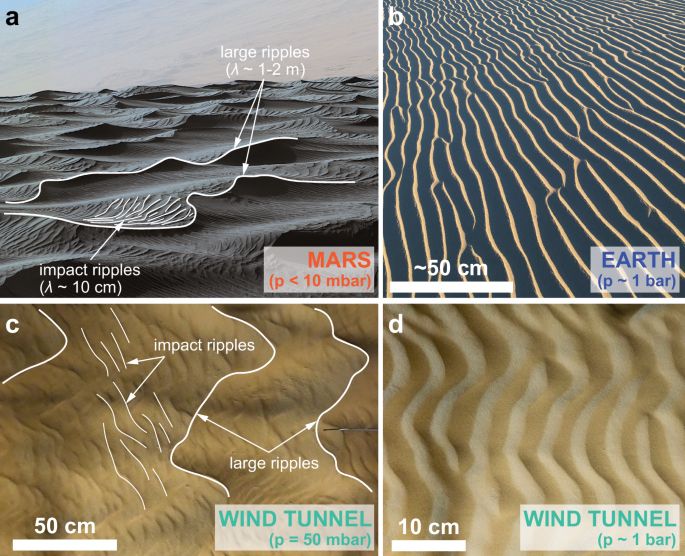
Ripples formed in low-pressure wind tunnels suggest Mars’s large windblown ripples are not impact ripples - Nature Communications
Low-pressure wind tunnel experiments suggest that large sand ripples on Mars are drag ripples, not impact ripples. Windblown drag ripples constitute an untapped record of atmospheric evolution under t...
www.nature.com
March 27, 2025 at 3:48 AM
Postdoc Carlos Alvarez shows that Mars’s large #aeolian #ripples are not impact ripples through low-pressure #wind tunnel experiments at #NASA Ames. Very excited about this one!
@stanforddoerr.bsky.social
www.nature.com/articles/s41...
@stanforddoerr.bsky.social
www.nature.com/articles/s41...
Reposted by M. Colin Marvin
PhD student Sophie Silver's first paper shows that crack geometry betrays presence of water on other planets! www.pnas.org/doi/10.1073/...
There's a nice write up in Penn Today here: penntoday.upenn.edu/news/penn-ca...
There's a nice write up in Penn Today here: penntoday.upenn.edu/news/penn-ca...
PNAS
Proceedings of the National Academy of Sciences (PNAS), a peer reviewed journal of the National Academy of Sciences (NAS) - an authoritative source of high-impact, original research that broadly spans...
www.pnas.org
March 6, 2025 at 2:57 PM
PhD student Sophie Silver's first paper shows that crack geometry betrays presence of water on other planets! www.pnas.org/doi/10.1073/...
There's a nice write up in Penn Today here: penntoday.upenn.edu/news/penn-ca...
There's a nice write up in Penn Today here: penntoday.upenn.edu/news/penn-ca...
Reposted by M. Colin Marvin
New paper by PhD student @mcolinmarvin.bsky.social uses #patterns formed by #dunes to better understand sources, pathways, and sinks of #sand on #Titan. Spoiler: #Xanadu has outsized influence on #eolian sediments, and sand travels far!!
@stanforddoerr.bsky.social
@stanforddoerr.bsky.social
Check out our paper in @agu.org where we provide evidence for a continuous transport pathway around Titan’s equatorial dune fields, only interrupted by the Xanadu region (with implications for the nature of Titan’s sand grains!) agupubs.onlinelibrary.wiley.com/doi/full/10....

March 5, 2025 at 12:29 AM
New paper by PhD student @mcolinmarvin.bsky.social uses #patterns formed by #dunes to better understand sources, pathways, and sinks of #sand on #Titan. Spoiler: #Xanadu has outsized influence on #eolian sediments, and sand travels far!!
@stanforddoerr.bsky.social
@stanforddoerr.bsky.social
Check out our paper in @agu.org where we provide evidence for a continuous transport pathway around Titan’s equatorial dune fields, only interrupted by the Xanadu region (with implications for the nature of Titan’s sand grains!) agupubs.onlinelibrary.wiley.com/doi/full/10....

March 4, 2025 at 6:16 PM
Check out our paper in @agu.org where we provide evidence for a continuous transport pathway around Titan’s equatorial dune fields, only interrupted by the Xanadu region (with implications for the nature of Titan’s sand grains!) agupubs.onlinelibrary.wiley.com/doi/full/10....
Reposted by M. Colin Marvin
8th International Planetary Dunes Workshop is held in Sassari/Alghero, Italy, from 19–22 May:
www.hou.usra.edu/meetings/dun...
🔔 Important Deadlines:
📌 Abstract submission: 12 March
📌 Registration: 31 March
www.hou.usra.edu/meetings/dun...
🔔 Important Deadlines:
📌 Abstract submission: 12 March
📌 Registration: 31 March

March 4, 2025 at 4:19 PM
8th International Planetary Dunes Workshop is held in Sassari/Alghero, Italy, from 19–22 May:
www.hou.usra.edu/meetings/dun...
🔔 Important Deadlines:
📌 Abstract submission: 12 March
📌 Registration: 31 March
www.hou.usra.edu/meetings/dun...
🔔 Important Deadlines:
📌 Abstract submission: 12 March
📌 Registration: 31 March
Reposted by M. Colin Marvin
Mars Wore Blue Velvet
The dark-blue and purple colors indicate coarse-grained sands that are comprised of basalt, an iron and magnesium-rich volcanic rock that formed from cooled lava millions of years ago.
uahirise.org/hipod/ESP_05...
NASA/JPL-Caltech/University of Arizona
#Mars #NASA #science
The dark-blue and purple colors indicate coarse-grained sands that are comprised of basalt, an iron and magnesium-rich volcanic rock that formed from cooled lava millions of years ago.
uahirise.org/hipod/ESP_05...
NASA/JPL-Caltech/University of Arizona
#Mars #NASA #science

February 5, 2025 at 1:45 PM
Mars Wore Blue Velvet
The dark-blue and purple colors indicate coarse-grained sands that are comprised of basalt, an iron and magnesium-rich volcanic rock that formed from cooled lava millions of years ago.
uahirise.org/hipod/ESP_05...
NASA/JPL-Caltech/University of Arizona
#Mars #NASA #science
The dark-blue and purple colors indicate coarse-grained sands that are comprised of basalt, an iron and magnesium-rich volcanic rock that formed from cooled lava millions of years ago.
uahirise.org/hipod/ESP_05...
NASA/JPL-Caltech/University of Arizona
#Mars #NASA #science
Had a wonderful time today! It was really great meeting you and thank for the invite to visit your fantastic department (and beautiful campus!)
Colin gave a talk at SCU ESS today on what sand dunes can tell us about environmental changes -- really interesting research and amazing imagery (including of Titan)!
dune find of the day: laterally linked and lone barchans in the Bodélé Depression, Chad (near 17.12°N, 17.87°E)
January 23, 2025 at 5:55 AM
Had a wonderful time today! It was really great meeting you and thank for the invite to visit your fantastic department (and beautiful campus!)
dune find of the day: laterally linked and lone barchans in the Bodélé Depression, Chad (near 17.12°N, 17.87°E)


January 7, 2025 at 4:41 AM
dune find of the day: laterally linked and lone barchans in the Bodélé Depression, Chad (near 17.12°N, 17.87°E)
Reposted by M. Colin Marvin
Final stop with postdoc Carlos Alvarez on the "Aerodynamic #roughness of rippled beds under active #saltation at low atmospheric #pressure" (EP54A-03, 146 B).
Fr 4:20-4:30 pm.
#Wind tunnel work reveals impact of #bedforms and #saltation on #Mars.
#AGU24
(10/10)
Fr 4:20-4:30 pm.
#Wind tunnel work reveals impact of #bedforms and #saltation on #Mars.
#AGU24
(10/10)
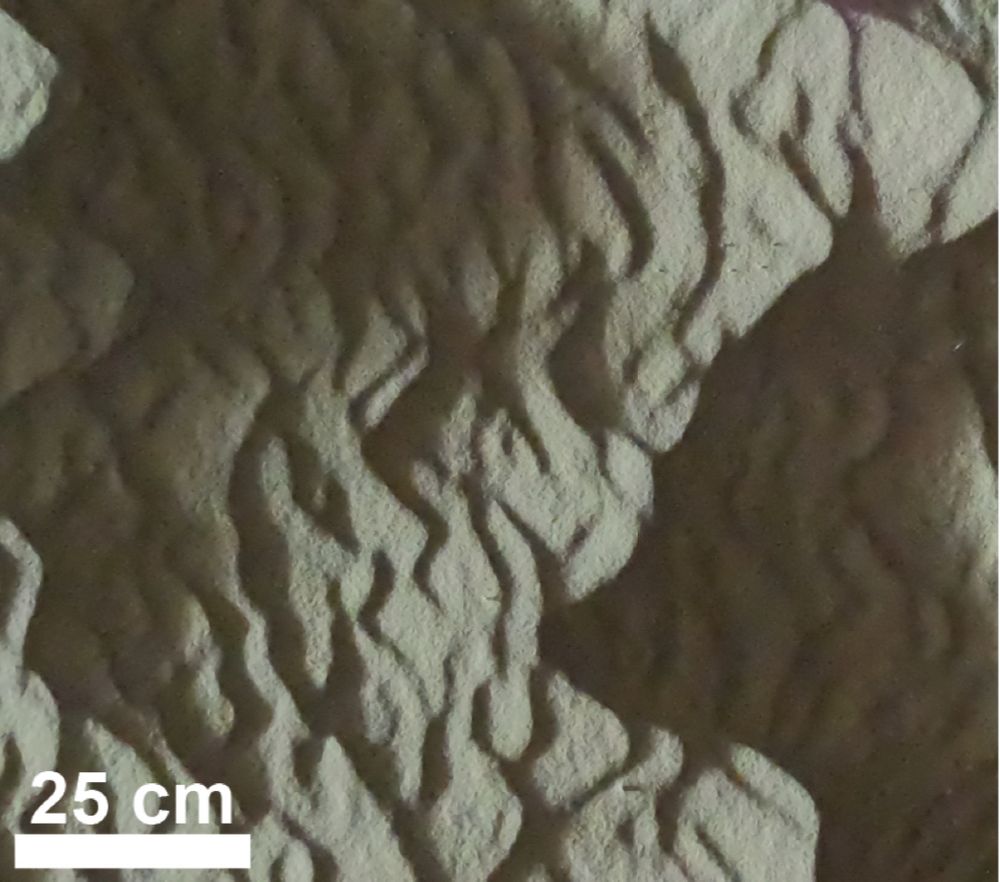
December 10, 2024 at 6:40 AM
Final stop with postdoc Carlos Alvarez on the "Aerodynamic #roughness of rippled beds under active #saltation at low atmospheric #pressure" (EP54A-03, 146 B).
Fr 4:20-4:30 pm.
#Wind tunnel work reveals impact of #bedforms and #saltation on #Mars.
#AGU24
(10/10)
Fr 4:20-4:30 pm.
#Wind tunnel work reveals impact of #bedforms and #saltation on #Mars.
#AGU24
(10/10)
Reposted by M. Colin Marvin
PhD student Timmy Lui will take us to #Mars for his " #Segmentation of #dune crestlines using #convolutional #neural #networks"
(EP51D-1378, hall B-C).
Fr 8:30 am-12:20 pm.
A challenging task with potential to reveal much about #Mars #climate!
#AGU24
(7/10)
(EP51D-1378, hall B-C).
Fr 8:30 am-12:20 pm.
A challenging task with potential to reveal much about #Mars #climate!
#AGU24
(7/10)
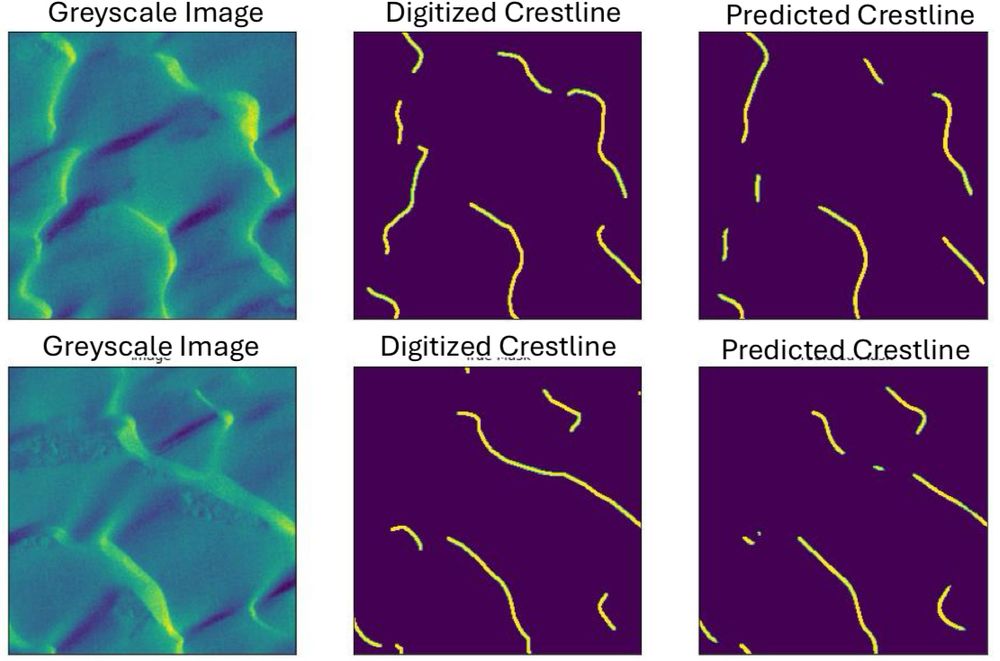
December 10, 2024 at 6:40 AM
PhD student Timmy Lui will take us to #Mars for his " #Segmentation of #dune crestlines using #convolutional #neural #networks"
(EP51D-1378, hall B-C).
Fr 8:30 am-12:20 pm.
A challenging task with potential to reveal much about #Mars #climate!
#AGU24
(7/10)
(EP51D-1378, hall B-C).
Fr 8:30 am-12:20 pm.
A challenging task with potential to reveal much about #Mars #climate!
#AGU24
(7/10)
Reposted by M. Colin Marvin
Reposted by M. Colin Marvin



